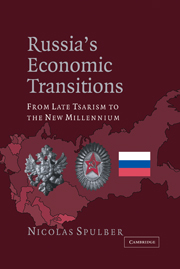Book contents
- Frontmatter
- Contents
- Figures and Tables
- Preface
- PART I THE TSARIST ECONOMIC TRANSITION
- PART II THE SOVIET ECONOMIC TRANSITION
- 10 The Socioeconomic Framework
- 11 The Transition Issues
- 12 The Economic Policies
- 13 The Problems of Agriculture
- 14 The Industrial Changes
- 15 Domestic and Foreign Trade
- 16 Money and Banking
- 17 State Finance
- 18 Overall View
- PART III THE POST-SOVIET ECONOMIC TRANSITION
- Index
10 - The Socioeconomic Framework
Published online by Cambridge University Press: 03 December 2009
- Frontmatter
- Contents
- Figures and Tables
- Preface
- PART I THE TSARIST ECONOMIC TRANSITION
- PART II THE SOVIET ECONOMIC TRANSITION
- 10 The Socioeconomic Framework
- 11 The Transition Issues
- 12 The Economic Policies
- 13 The Problems of Agriculture
- 14 The Industrial Changes
- 15 Domestic and Foreign Trade
- 16 Money and Banking
- 17 State Finance
- 18 Overall View
- PART III THE POST-SOVIET ECONOMIC TRANSITION
- Index
Summary
Territory and Population
The Soviet Union succeeded the Tsarist reign after the revolution of October 1917. The Union lasted seventy-three years, after which it collapsed and was dismembered in 1990–1. During its existence, the Union's socioeconomic and juridical framework underwent a number of crucial transformations. Immediately after the revolution, during the Civil War, the Bolsheviks in power established what came to be known as the rule of War Communism (1917–21), which aimed on the economic plane at eliminating market relations and replacing them with an all-out system of centralized commands and controls. This system was in turn discarded in 1921 and replaced by a new coordinating mechanism called the New Economic Policy (NEP) (1921–8), which aimed at economic recovery and reconstruction and which for the purpose combined centralized command with the reestablishment of certain market relations. The NEP was followed in 1928 with an all-embracing policy of massive industrialization and of collectivization of the peasantry, inaugurating the era of Central Plans. After World War II, various attempts at reforming the planning system were undertaken, notably in the 1960s and then in the 1980s. The first became known as “The New System of Planning and Economic Incentives,” the second, much vaster in scope, named perestroika (restructuring), aimed at eliminating many aspects of the inefficient and disintegrating central planning system and at returning in some respect to the organizational concepts of the NEP.
I will examine in detail each of these phases later on.
- Type
- Chapter
- Information
- Russia's Economic TransitionsFrom Late Tsarism to the New Millennium, pp. 155 - 173Publisher: Cambridge University PressPrint publication year: 2003



